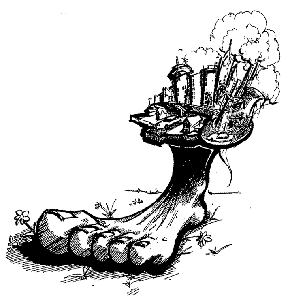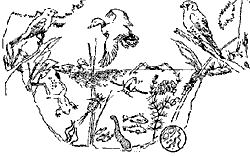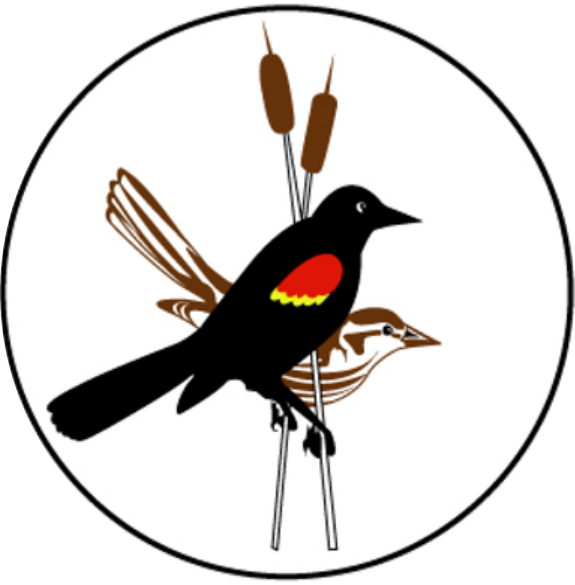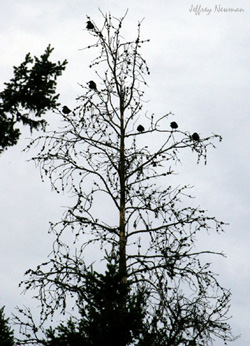“It is wonderful how completely everything in wild nature fits into us. The sun shines not on us, but in us. The rivers flow not past, but through us, thrilling, tingling, vibrating every fiber and cell of the substance of our bodies, making them glide and sing.” – John Muir

Scout Island Nature Centre believes that children, indeed all humans, need to bond with the world around us through exploring nature. Discovering the outdoors leads to a love for and understanding of the natural world and can motivate us to live as part of the web of life. We use the concept of Ecological Footprint to help people define actions they can take to live in harmony with all creation.
What is an Ecological Footprint?
Your Ecological Footprint (Eco Print, for short) is a measure of the biologically productive area needed to produce the resources you use and to absorb the waste you generate. Do you know just how much land, water and air is needed to put that toothbrush in your hand? Your Eco Print reflects the effect of your consumption and waste on Climate Change, Air and Water Pollution, and Habitat Alteration. The measure of your Eco Print provides an estimate of how your lifestyle is affecting the health of our planet and how well you are fitting into the web of life.
Why Should Your Eco Print Shrink?
At the present population, there are only 1.9 global hectares of biologically productive space available for each person on Earth. If we re-calculate that number to include untouched wild space for other species, it drops to 1.5 hectares Therefore, our fair “earthshare” is only 1.5 hectares. The average world citizen has an Ecological Footprint of 2.3 global hectares. Canadians are not average world citizens; we use an average of 6.9 hectares each. If everybody lived like today’s Canadians, it would take at least 5.9 additional planet Earths to produce the resources, absorb the wastes, and otherwise maintain life-support.
Unfortunately, good planets are hard to find.
Let’s Shrink our EcoPrint
“If you think you are too small to be effective, you have never been in bed with a mosquito” – Betty Reese
 Each of us can live responsibly by making smart, informed choices in the four areas of daily living that have the greatest environmental impact:
Each of us can live responsibly by making smart, informed choices in the four areas of daily living that have the greatest environmental impact:
- Transportation
- Food
- Home
- Stuff
It really comes down to using less Stuff
 Rethink and Reduce — Think before you acquire. Do you need it or just want it? Wait a week; if you still want it, research the product (the total cost of producing, transporting and disposing of it)
Rethink and Reduce — Think before you acquire. Do you need it or just want it? Wait a week; if you still want it, research the product (the total cost of producing, transporting and disposing of it)- Re-use — Buy items that are used or made from recycled materials. Donate what you don’t want to someone who does want it.
- Repair and only then Recycle — Only when the item cannot be used again in its present form.
 Ways You Can Shrink Your Eco Print on the Web of Life of the Marsh
Ways You Can Shrink Your Eco Print on the Web of Life of the Marsh
Home: Turn your thermostat down and less carbon dioxide will go into the air causing climate change — Bird migration times will continue to match the time that bugs are available for them to eat and the birds of marsh will do well.
 Food: Buy your food from local growers who do not use pesticides — Pesticides won’t work up the food chain from bugs, to frogs to birds.
Food: Buy your food from local growers who do not use pesticides — Pesticides won’t work up the food chain from bugs, to frogs to birds.
Stuff: Wear used clothing and less land and water will be needed to manufacture and dye cloth — Marshes and lakes will not be hurt by the run-off from textile factories.
Transportation: Keep your car tuned (no oil drips) and use it less so that fewer pollutants wash into the marsh and waterway — aquatic bugs and fish will not be harmed by the pollutants.
Click: An Eco Print story for children – Do Moose Have Big Feet? – download for your own use
Spawning Stories, Hatching Change – a story-making adventure for the rural voice
Our watersheds are alive with stories — human lives, animal tales, ecosystem networks. Telling the world’s stories has always been the essence of the arts. “Spawning Stories, Hatching Change” is a project of Scout Island Nature Centre, bringing story-makers into the landscape to discover and tell the stories of human impacts on the web of life. Stories can be powerful teachers. The author learns from the story as it is created. The listener learns as she connects with the story (if it is a good one). Stories have an impact not because they contain a large amount of information, but because they can catalyze change.
Creating a story that is both engaging and catalyzes behaviour change is not easy. The “Spawning Stories Hatching Change” process helped to motivate people to create stories that engage the people of the Cariboo Chilcotin and reminds them of their place in the natural world. The most significant stories and songs came from participants who took part in the whole process:
- A field trip, led by a naturalist who skillfully guided participants through activities encouraging observation and appreciation of the environment they were exploring. As well, the leader incorporated ideas of the human effects on this environment and presented Eco Print concepts within this setting — not as a lecture but emerging organically from what is being enjoyed.
- A creative workshop (story, song, or drama) mentored by a skilled artist who participated in the field trip. The mentor guided participants in creating stories reflecting themes that emerged from the field trip. The mentor subsequently provided guidance and editing to help polish the stories.
- Participants presented their stories to an audience.
If you would like to see the full report of the first year of this project (2010), which was funded by the Fraser Salmon and Watershed Program, please contact Sue Hemphill 250 398 8532 or e-mail . She will share with you the process we used — what worked and what didn’t. There is also a DVD of some of the stories that were presented. The project is ongoing, as we will work further with school children of all ages as part of the language arts curriculum.
The following are some of the stories that have been produced so far by students and members of the public:
| Coyote Spring
The sun rises, high into the sky Their big ears pivot to every sound Their barks come deep, out from their throats They ran quickly with great strength and speed Amy Janelle Sarnowski, grade 8 |
Jammin’ for Salmon
Oh Mr. King Fisher looking at me Mike, Grade 12 |
| Laughing Loon
Elegant, swift, smart Montana Reid & Sissy, grade 8 |
SWAN
Striking SWAN Anne B. Alexa N. grade 8 |
| Web of Life
Care for the caribou! Daven, age 11 |
The Struggle
The struggle that you hear of is true. By grade 8 |
| Eagle
Mighty, wise, unwavering, diving, twirling, flapping, grabbing, clutching, loving. Parker
The amount of farming we do has expanded over the years. So has the number of crows that hang around here. All spring, we watch them gather straw, small twigs, animal hair, and other things as they build their nests and prepare for their young. They are arrogant and noisy. Sometimes they are a nuisance (like when they steal eggs from the chicken coop). And sometimes they are an asset, especially when they go down the broccoli row and carefully pick the green worms off the leaves of the plants. Most of the time, we don’t take much notice of them at all. They’re just there. But we always notice them when an eagle flies overhead. They band together in a group of sometimes as many as 30 birds, squawking like crazy and dive-bombing the eagle. On occasion, we have even found birds that have been badly injured in this aerial strafing. We were always impressed by their teamwork and their displays of courage, but we never could figure out exactly why all this was happening; and it was happening on an almost daily basis. It was only a few summers ago when we watched an eagle, scouting from above, and looking in the trees that surround our fields for the nests of the crows. When sighted, the eagle would dive down and grab the young with its talons from the nest (presumably feeding its own young). Once aware of the scenario, we saw these successful hunts many times in a single season. After that, the hapless crows would call for hours for their missing young. This little story says lots about the opportunities for observation that are provided by spending so much time outdoors; it also hints at the complex dynamics of survival that are always at play around us.
|
Strangest Dream
Last night I had the strangest dream And the river no longer ran with red
Turns out they could smell the water that flowed Their moms used their powerful side-to-side tails
Then the bears dragged the carcasses into the woods People that fished here for 10,000 years
The eagles and grizzlies stood by the people’s side I sat up in bed, raised my hands to my head Go to www.
Jenny Noble (Singing of this is on our DVD) |


